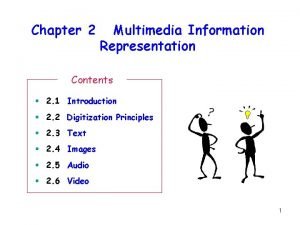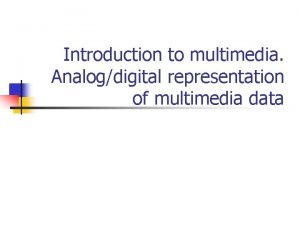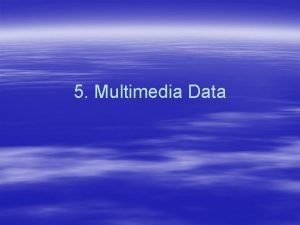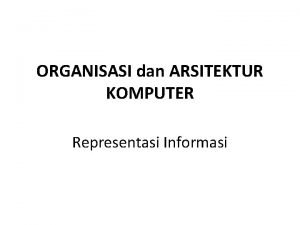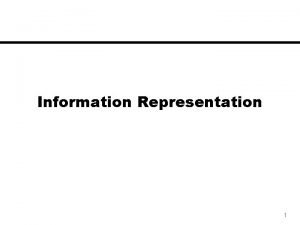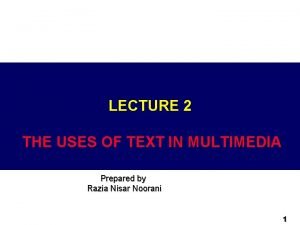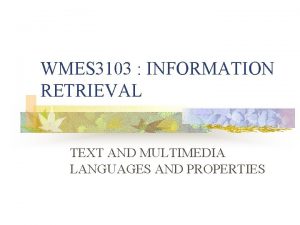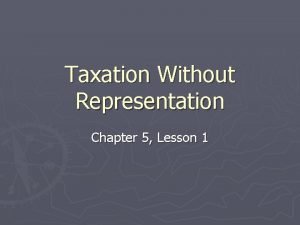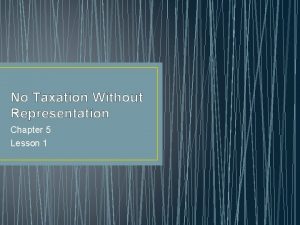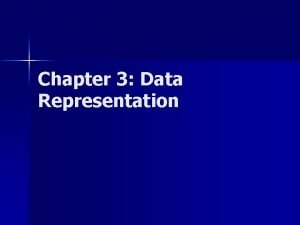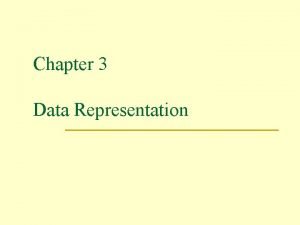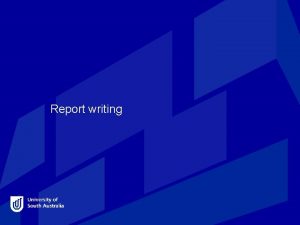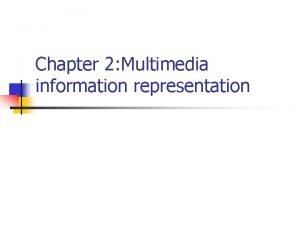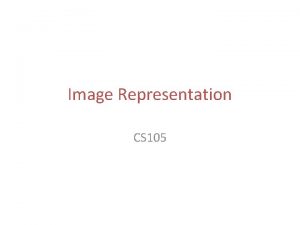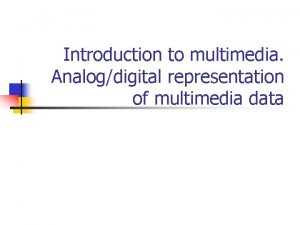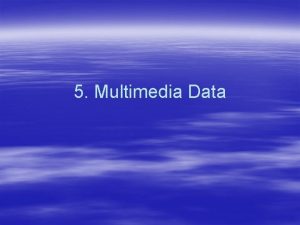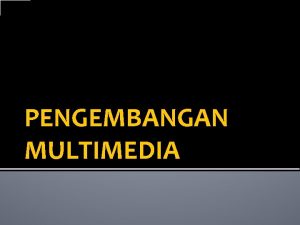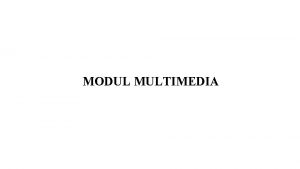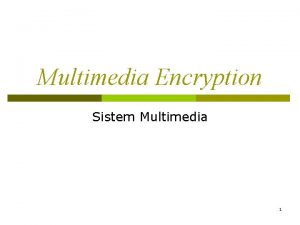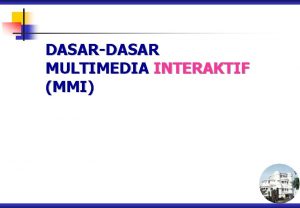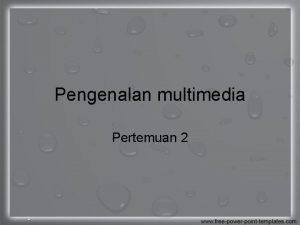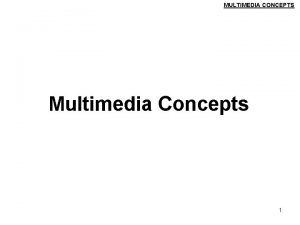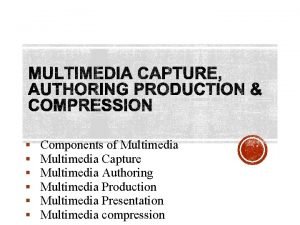Chapter 2 Multimedia Information Representation Contents 2 1



































- Slides: 35

Chapter 2 Multimedia Information Representation Contents § 2. 1 Introduction § 2. 2 Digitization Principles § 2. 3 Text § 2. 4 Images § 2. 5 Audio § 2. 6 Video 1

2. 1 Introduction § Codeword: a fixed number of bits representing a set of symbols, e. g) ASCII Code, FAX Run-length Code, …. § Signal Encoder § Signal Decoder Audio-Video CODEC (Coder -Decoder) § CODEC performs the conversion using some codewords Data con ver Host Network Host n sio r e v con sion Data (or Signal) conversion Signal (or Data) conversion Data (or Signal) 2

2. 2 Digitization Principles (1) (Analog Digital) terms - Spectrum VS. Bandwidth - Signal bandwidth VS. Channel (Bandlimiting) bandwidth - Cutoff frequency = min {Signal bandwidth, Bandlimiting bandwidth} Analog Digital A/D Converter Bandlimiting Filter Sampler Quantizer & Coder D/A Converter Decoder Digital Host Encoder conversion Networks Transfer Lowpass Filter Analog Decoder Host conversion 3

Encoder e r M u C P ced pro Bandlimiting filter Analog input signal A 대역 제한 필터 Sampler (sample-and-hold) B clock 표본화 Quantizer D C 양자화 Encoder E 부호화 F time A B Network C D 0 E F 4 7 Decoder 3 5 -4 0 000 -5 -3 0 100 0 111 0 011 1 100 1 101 1 011 0 101 Lowpass filter DAC DA 변환 G 저 대역 필터 G H 0 101(1 -bit sign & 3 -bit amplitude magnitude) H Analog output signal 4

2. 2 Digitization Principles(2) (Analog Digital) § Analog Signal § Bandwidth, B Hz, via bandlimiting channel (see the next slide) § Encoder § Bandlimiting filter signal D Dynamic range of ) D=20 log 10(Vmax/Vmin § Sampling: 2 B sps(samples per sec) aliasing may happen ! § Quantizing: Aliasing filter for eliminating alias signals § quantization interval q = 2(Vmax/2 n) § quantization § Decoder error/noise = q/2 n: # of bits Vmax: max(min) positive (negative) signal amplitude § low-pass filter (= bandlimiting filter = anti-aliasing filter) 5

2. 2 Digitization Principles (3) ation n i (Analog Digital) m i l e s l & it a amplitude When does aliasing occur ? T sign Aliasing If the sampling rate is lower than the Nyquist rate 6 KHz real signal 2 KHz alias signal because of time T’ = 3 T 6 KHz sine-wave is sampled at 8 Ksps, lower than the Nyquist rate 12 Ksps(2 6 KHz) 8 Ksps Conclusion All frequency components in the source signal that are higher in frequency than half the sampling frequency being used will generate related lower-frequency alias signal which will simply add to those making up the original thereby causing it to become distorted Resolution Using “bandlimiting filter”, let’s pass only those Frequency components up to that determined by the Nyquist rate bandlimiting filter = anti-aliasing filter = low-pass filter = reconstruction filter 6

2. 2 Digitization Principles (4) (Analog Digital) § Example 2. 2 An analog signal has a dynamic range of 40 d. B. Find the magnitude of the quantization noise relative to the minimum signal amplitude if the quantizer uses 1) 6 bits and 2) 10 bits § Solution � It follows that 40 = 20 log 10(Vmax/Vmin) by assumption and finally the equation 102 = Vmax/Vmin results in Vmin = Vmax/100 � And the quantization noise is determined by q/2 where, q is the quantization interval given by q =2(Vmax/2 n). Thus q/2= Vmax/2 n. � For n =6, q/2= Vmax/2 n(= Vmax/64) > Vmin(=Vmax/100) unacceptable ! For n =10, q/2= Vmax/2 n(= Vmax/1024) < Vmin(=Vmax/100) acceptable ! 7

d. B ibel c de § d. B (decibel) : The decibel measures the relative strength of two signals or a signal at two different points p 1 and p 2 given by d. B = 10 log 10(p 2/p 1) p 1 If a signal power is reduced to half at p 2 such that p 2=p 1/2 10 log 10(p 2/p 1) = 10 log 10(0. 5 p 1/p 1)= 10 log 10(1/2) = 10 log 101 - 10 log 102= -3 d. B irritating p 2 8

2. 3 Text § Unformatted Text, Plaintext § String of fixed-size characters § ASCII, Mosaic Characters, …. Well-defined code-words are used for Text Creation & Manipulation § Formatted Text § String of characters of different sizes, styles & shapes with table, figures (graphics) & images § Latex, Acrobat, …. § Hypertext § Integrated set of documents comprising formatted & unformatted texts with linkages among them § HTML, Postscripts, SGML, …. 9

2. 4 Images § Image (still picture) Classification § Computer-generated images (computer graphics) e. g) palette files § Digitized images of documents and/or pictures VGA 640 480 (=열수 행수) pixels 8 -bits/pixel e. g) fax-scanned files, scanned color-image files § Graphics § high-level language form: description of attributes of objects § bit-map form: actual pixel-images § gif: graphical interchange format pixel (or pel): § tiff: tagged image file format picture element § srgp: simple raster graphics package § Digitized Documents § Facsimile (FAX) machine, about 2 Mbits/page(black-white/pixel) § Pixel resolution: 8 per mm § Line resolution: 3. 85 or 7. 7 per mm(100 or 200 lines per inch) 10

Digitized Pictures(1) pth: el e d l e pix s per pix of bit § m-bit per pixel (pixel depth m) # § good-quality black-white picture: 8 -bit/pixel(256 gray levels) § colored-picture: 24 -bit/pixel(R/G/B each 8 -bit yielding 16 M colors) § Coloring Principles : How is color produced and represented ? 참고 § Color gamut(색상범위 색대역): a whole spectrum of colors 하기 1 § Three primary colors(삼원색): R (Red), G (Green), B (Blue) § all kind colors are produced by using different proportions of these primary colors § Additive Color Mixing (가산혼합) on a black surface 참고 하기 2 § Subtractive Color Mixing (감산혼합) on a white surface § Raster-Scan Principles: TV Screen or Computer CRT Monitor § NTSC (National Television Standards Committee)-USA § 525(active 480) lines/frame & 60 -time refresh rate/sec § PAL (Phase Alternation Line)/CCIR/SECAM § 625(active 576) lines/frame & 50 -time refresh/sec 11

Digitized Pictures(2) Scanning Order Sweep 1 2 3 4 5 1. N=525(NTSC) & 625(PAL/SECAM/CCIR) TV 2. fresh rate (Hz) = 60(NTSC) & 50(PAL/SECAM/CCIR) 3. M is determined by the aspect ratio (see the next slides) frame : a complete set of N horizontal scan lines N 1 2 3 frame refresh rate: # of frames per sec at least 50 Hz to avoid flickering M Retrace Scanning Method Mx. N 행렬 Progressive scanning : 1 2 3 … N: one frame 60 or 50 Hz refresh rate (전진주사) Interlaced scanning : 1 3 5 … N-1: first half frame (field) (격월주사) 2 4 6 … N: 2 nd half frame (filed) 30 or 25 Hz refresh rate 12

Digitized Pictures(3) § Raster-Scan Principles § Raster(래스터): a finely-focused electro beam in HTML #FFFFFF § Phosphor(발광체): a light-sensitive material that emits light when energized § white-sensitive phosphor: a single electron beam used § color-sensitive phosphor : each pixel comprises a set of three color-sensitive phosphors, one each for R, G, B signals, called phosphor triad spot size: 0. 635 mm(0. 025 inch) § beam signal may be either analog or digital form § Pixel Depth: # of bits per pixel § CLUT (Color Look-Up Table): 24 -bit/pixel yields 224 colors. But eye discriminates between some ranges of colors hence, each pixel value is used as an index on CLTT of 256 colors (compression achieved !) 13

Digitized Pictures(4) § Aspect Ratio: ratio of the screen width to the screen height § NTSC, 525 scan lines/frame ⇒ 480(45) data (control) lines § 4/3 aspect ratio ⇒ 480 4/3(=640) pixels/line § 16/9 aspect ratio ⇒ 480 16/9(=853. 33) pixels/line Representing an M N pixels under a particular aspect ratio § PAL/CCIR/SECAM 625 lines/frame ⇒ 576(49) data (control) lines § 4/3 aspect ratio ⇒ 576 4/3(=768) pixels/line § 16/9 aspect ratio ⇒ 576 16/9(=1024) pixels/line Computer Graphics Array standard resolution VGA 640 x 480 x 8 XGA 640 x 480 x 16 1024 x 768 x 8 800 x 600 x 16 1024 x 768 x 8 1024 x 768 x 24 SVGA ate: r h s e refr Hz 50 -70 #of colors 256 64 K 256 16 M Bytes/frame 307. 2 K 614. 4 K 786. 432 K 960 K 786. 432 K 2359. 296 K 14


Digitized Pictures(5) § Example 2. 3 Derive the time to transmit the following digitized images at both 64 Kbps and 1. 5 Mbps networks § a 640 480 8 VGA-compatible image § a 1024 768 24 SVGA-compatible image § Solution The size of each image in bit is as follows § a VGA image = 640 480 8 = 2. 46 Mbits § an SVGA image = 1024 768 24 =18. 88 Mbits The time to transmit each image is given as follows § at 64 Kbps : VGA = 2. 46 Mbits/64 Kbps = [2. 46 106]/[64 103] = 38. 4 sec. SVGA = [18. 88 106]/[64 103] = 295 sec. § at 1. 5 Mbps: VGA = 2. 46 Mbits/1. 5 Mbps = [2. 46 106]/[1. 5 106] = 1. 64 sec. SVGA = [18. 88 106]/[1. 5 106] = 12. 59 sec. 16

Digitized Pictures(6) § Digital Cameras & Scanners § (Still image cameras) 2 -D grid of photo-sites (빛 감지 diode), light-sensitive cells, made of charge-coupled devices (CCD’s) § level of light intensity on each photosites is converted into a digital value using an AD converter when the shutter is activated § (Scanners) single-row of photo-sites is exposed in timesequence with the scanning operation § How are color images obtained ? § each photosite/pixel is coated with R/B/G filter & the General color is determined by the level of it together with consumer 8 neighbors in a 3 x 3 grid structure § use of three separate exposures of a single photosite, say, Photo first R filter, 2 nd G filter, and finally B filter studio § use of three separate image sensors per pixel professional § e. g) TIFF (tagged image file format), TIFF/EP for electronic photography 17

2. 5 Audio § Typical Audio Types § Speech signal for interpersonal application such as (video) telephony § Music-quality audio such as CD-on-demand & broadcast TV § synthesizer § microphone § loudspeaker Basics on Audio Signals 1. Human speech: 50 Hz -10 KHz (4 Khz in a plain-old-telephone system) - 2 x 10 K or 2 x 8 K sps monaural (mono) speech - (2 x 10 K) x 2 or (2 x 8 K) x 2 sps stereophonic speech - ideally, 12 bits/sample c. e s r e p 2. Human audible music: 15 Hz - 20 KHz s e l p am s : s - 2 x 20 K sps monaural (mono) music p s - (2 x 20 K) x 2 sps stereophonic music - ideally, 16 bits/sample 18

PCM Speech(1) § Human Voice over PSTN § 200 Hz-3. 4 Khz bandlimiting channel: about less than 4 Khz § 8 K(2 x 4 K) sps, 8 bits/sample : ITU-T G. 711(PCM) recommendation § Companding (compressing/expanding) § 1 -bit: polarity, 3 -bit: segment code, 4 -bit: quantization code Pure PCM signals Compander (compressor/expander) Equal (linear) interval quantization & same level of quantization error Irrespective of the magnitude of the input signal , the same error level for both low (quiet) signals and high (loud) signals is produced Enhanced PCM signals Non-linear (unequal) interval quantization & narrower intervals for smaller amplitude signals Why companding ? Because the human ears are more sensitive to noise on quiet signals than it is on loud signals. Hence the effect of quantization noise (error) can be reduced with companding 19

PCM Speech(2) § Companding Example: 5 -bit per sample(1 -bit polarity, 2 -bit segment code, & 2 -bit quantization code) co g n i s s e m pr 11 10 01 00 -V Linear quantization intervals signal 11 10 01 00 Polarity: 1 Segment codes(+) +V -V 00 01 10 +V Segment codes(-) Polarity: 0 Narrower intervals for smaller amplitude 00 01 10 11 11 20

PCM Speech(3) § Companding Example: 5 -bit per sample(1 -bit polarity, 2 -bit segment code, & 2 -bit quantization code) ing d n a Exp 11 10 01 00 Linear quantization intervals signal 11 10 01 00 Polarity: 1 Segment codes(+) +V -V 00 01 10 Segment codes(-) Polarity: 0 Wider intervals for smaller amplitude 00 01 10 11 11 21

PCM Speech(4) § Two Companding Codewords for PCM § μ -law: North America & East Asia § A-law: Europe μ-law +127 +96 +64 +32 +0 -0 -32 -64 -96 -127 Sign bit (polarity) 1 0000000 1 0011111 1 0111111 1 1011111 1 1111111 0 1011111 0 0111111 0 0000000 “Si gne rep d & m res agn ent itu ati de” on A-law 1 1111111 1 1100000 1 1000000 1 0100000 1 0000000 0 0100000 0 1000000 0 1111111 1’s complement 22

CD-Quality Audio § Human audible bandwidth: 15 Hz-20 Khz 40 Ksps § In CD-ROMs, more higher, say, 44. 1 Ksps & 16 -bit/sample used § bit rate for channel = sampling rate x bits per sample = 44. 1 x 103 x 16 = 705. 6 Kbps § total rate required for stereophonic music = 2 x 705. 6 = 1. 411 Mbps § storage capacity for a 1 hour CD-ROM title = 1. 411 x 60 = 634. 95 Mbytes this takes (634. 95 x 106 x 8)/(10 x 106) = 8. 5 min. down-loading time via a 10 Mbps link network ! 23

Synthesized Audio § A digitized audio requires a large amount of memory while a synthesized audio is 1) 2 or 3 orders of magnitude less 2) much easier to edit & to mix several passes together § An audio/sound synthesizer: computer + keyboard + a set of sound generators + interfaces for instruments (elec. guitar) * MIDI (Music Instrument Digital Interface): Standard I/O interfaces - Messages (status byte + data bytes) - Connectors, Cables, & Electrical Signals 24

2. 6 Video (Motion): Broadcast TV Video Applications § Entertainment: Broadcast TV, VCR/DVD Recordings § Interpersonal: Video Telephony & Videoconferencing § Interactive: Video Clips on PC Windows § Scanning Sequences: Interlaced Scanning § To minimize the amount of tx bandwidth, a frame is divided into two halves called fields e. g) 525 -line 50 -time frame refresh rate/sec. - 262. 5 odd lines 50 -time field rate/sec. - 262. 5 even lines 50 -time field rate/sec. In reality, 525 -line 25 -time frame refresh rate/sec. 25

Broadcast TV(2) § Color Signals § Three properties of a color - Brightness, Hue (Tint) & Saturation Luminance: 휘도 Brightness: 밝기 Hue (Tint): 색조/색상 Saturation: 채도 Chrominance: 색차 § Color production: an equation of R, G, and B phosphors - 0. 299 R + 0. 587 G + 0. 114 B where, 0. 299+0. 587+0. 114=1 § Luminance refers to the brightness of a source, the hue & the saturation called, chrominance characteristics -say, luminance Ys = 0. 299 Rs + 0. 587 Gs + 0. 114 Bs Ys: magnitude of luminance signal Rs, Gs, Bs: magnitudes of three major colors § Two color difference signals: Blue chrominance Cb and Red chrominance Cr - Cb = Bs-Ys, Cr = Rs -Ys 26

Broadcast TV(3) § Chrominance Components § Composite Video Signal for Transmission - Ys, Cb, and Cr signals are combined together and signal differences are scaled down before transmission § In PAL - Y = 0. 299 R + 0. 587 G + 0. 114 B - U(Cb) = 0. 493(B-Y) = -0. 147 R-0. 289 G+0. 437 B - V(Cr ) = 0. 877(R-Y) = 0. 615 R-0. 515 G-0. 1 B § In NTSC - Y = 0. 299 R + 0. 587 G + 0. 114 B - I(Cb) = 0. 74(R-Y)-0. 27(B-Y) = 0. 599 R-0. 276 G-0. 324 B - Q(Cr ) = 0. 48(R-Y)+0. 41(B-Y) = 0. 212 R-0. 528+0. 311 B 27

Digital Video § Advantages of DV § Easy to store in computer § Easy to edit and integrate with other types § Easy to digitize three RGB component signals § The resolution of eyes are less sensitive for color than it is for luminance. Hence, two chrominance signals can tolerate a reduced resolution § Transmission bandwidth is achieved by using the luminance and two color difference signals, instead of the RGB signals directly. § CCIR-601 Recommendations: standard for the digitization of video pictures 28

Digital Video(2) § 4: 2: 2 format(CCIR-601) § Recommendation for use in TV studio Y Cb Cr § Three component (analog) video signals may have bandwidths § up to 6 Mhz for the luminance ⇒ 12 Mhz sps § less than 3 Mhz for the two chrominance signals ⇒ 6 Mhz sps § In reality, 13. 5 M sps for luminance, 6. 75 M sps for the two chrominance signals § In NTSC(525 -line) system, total line sweep time 63. 56μsec = retrace time 11. 56 μsec + an active line sweep time 52 μsec § In PAL(625 -line) system, total line sweep time 64μsec = retrace time 12 μsec + an active line sweep time 52 μsec Line sampling rate: Orthogonal sampling. Line sampling rate: 52 10 -6 13. 5 106 = 702 samples/line 52 10 -6 6. 75 106 = 351 samples/line In reality, 720 samples/line In reality, 360 samples/line 4 Y samples for every 2 Cb and 2 Cr samples(4: 2: 2) 29

Digital Video(3) § 4: 2: 2 Format Bit Rate & Storage (NTSC 525 -line) PAL e -lin 5 2 6 § The number of active (visible) lines: 480 576 § The number of samples per line: 720 6 Resolution of luminance Y = 720 480 720 57 76 Two chrominance signals Cb = Cr = 360 480 360 5 § Line sampling rate: 13. 5 sps for Y & 6. 75 sps for both Cb & Cr § Bits per sample: 8 bits Bit rate per line = 13. 5 106 8 + 2 (6. 75 106 8) = 216 Mbps Bits per line = 720 8 + 2 (360 8) = 11. 52 Kbits ts i 76 b M 5 Bits per frame = 480 11. 52 = 5. 5296 Mbits 6. 63555 Bits for 1. 5 hrs Video assuming 60 refresh rate = 5. 5296 60 1. 5 3600 50 5 5 5 = 223. 9488 GBytes 3 6. 6 30

Digital Video(4) § 4: 2: 0 Format § used in Digital Broadcast Applications § interlaced scanning with the absence of chrominance samples in alternative lines § 525 -line system § Y = 720 480(the same as 4: 2: 2 format), Cb = Cr = 360 240 § 625 -line system § Y = 720 576, Cb = Cr = 360 288 § bit rate per line: 13. 5 106 8 + 2 (3. 375 106 8) = 162 Mbps § HDTV Format § used in High-Definition Television (four times bit rate) § 4/3 1440 1152 pixels(50/60 Hz refresh rate) & 16/9 wide-screen 1920 1152 pixels(25/30 Hz) with # of visible lines per frame 1080 31

Digital Video(5) § SIF (Source Intermediate Format), 4: 1: 1 Format § used in Video Cassette Recorders (VCRs) § progressive (non-interlaced) scanning since it is intended for storage applications § Half of 4: 2: 0 format: “Subsampling & Temporal Resolution” § 525 -line system § Y = 360 240, Cb = Cr = 180 120 § 625 -line system § Y = 360 288, Cb = Cr = 180 144 § bit rate per line § 6. 75 106 8 + 2 (1. 6875 106 8) = 81 Mbps 32

Digital Video(6) § CIF (Common Intermediate Format), 4: 1: 1 format § used in Video Conferencing applications § spatial resolution of the SIF 625 -line system plus temporal resolution of the SIF 525 -line system § Y = 360 288, Cb = Cr = 180 144 § refresh rate: 30 Hz § bit rate per line: 6. 75 106 8 + 2 (1. 6875 106 8) = 81 Mbps § many variants for videoconferencing using desktop PCs or ISDN/PSTN § say, typically 4 or 16 64 Kbps channels used § 4 CIF: Y = 720 576, Cb = Cr = 360 288 § 16 CIF: Y = 1440 1152, Cb = Cr = 720 576 33

Digital Video(7) § QCIF (Quarter CIF), 4: 1: 1 Format § used in Video Telephony applications § half spatial resolution of the CIF and either half or quarter temporal resolution of the CIF § Y = 180 144, Cb = Cr = 90 72 § refresh rate: 15 or 7. 5 Hz § bit rate per line: 3. 375 106 8 + 2 (0. 84375 106 8) = 81 Mbps § a lower version is typically used for single 64 Kbps channel ISDN or PSTN with modems: sub-QCIF(SQCIF) § Y = 128 96, Cb = Cr = 64 48 34

Digital Video(8) § PC Video Digitization Format System Spatial Resolution Temporal Resolution 4: 2: 2 525 -line 625 -line Y = 640 480, Cb = Cr = 320 240 Y = 768 576, Cb = Cr = 384 288 60 Hz 50 Hz SIF 525 -line 625 -line Y = 320 240, Cb = Cr = 160 240 Y = 384 288, Cb = Cr = 192 144 30 Hz 25 Hz CIF Y = 384 288, Cb = Cr = 192 144 30 Hz QCIF Y = 192 144, Cb = Cr = 96 72 15/7. 5 Hz - Video capture board or S/W required - All PC monitors use “progressive (non-interlaced) scanning” 35
 Cp 4k786
Cp 4k786 Video representation in multimedia
Video representation in multimedia Digital representation in multimedia
Digital representation in multimedia Multimedia becomes interactive multimedia when
Multimedia becomes interactive multimedia when Linear multimedia presentation
Linear multimedia presentation Csc253
Csc253 Esa multimedia.esa.int./multimedia/virtual-tour-iss
Esa multimedia.esa.int./multimedia/virtual-tour-iss Information representation in computer
Information representation in computer Computer memory representation
Computer memory representation Uses of text in multimedia
Uses of text in multimedia Spoken language audio retrieval in irs
Spoken language audio retrieval in irs Chapter 5 lesson 1 no taxation without representation
Chapter 5 lesson 1 no taxation without representation Lesson 1 no taxation without representation
Lesson 1 no taxation without representation Chapter 3 data representation
Chapter 3 data representation Chapter 3 data representation
Chapter 3 data representation Introduction for portfolio
Introduction for portfolio Deep perineal pouch contents
Deep perineal pouch contents Febrile non hemolytic transfusion reaction
Febrile non hemolytic transfusion reaction Febrile non hemolytic transfusion reaction
Febrile non hemolytic transfusion reaction Middle mediastinum: contents mnemonic
Middle mediastinum: contents mnemonic Knee blood supply
Knee blood supply Level of the sternal angle
Level of the sternal angle The immortal life of henrietta lacks table of contents
The immortal life of henrietta lacks table of contents Medial lemniscus
Medial lemniscus M
M Contents of the ark of the covenant
Contents of the ark of the covenant So we meet again my dear doctor
So we meet again my dear doctor Mesenteric root
Mesenteric root Mla table of contents
Mla table of contents Stylistic synonyms lexicology
Stylistic synonyms lexicology Front cover page for school magazine
Front cover page for school magazine Examples of continuous variables
Examples of continuous variables Appendix in report
Appendix in report Cryoprecipitate components
Cryoprecipitate components Subdivision of mediastinum
Subdivision of mediastinum Pericardium mediastinum
Pericardium mediastinum
